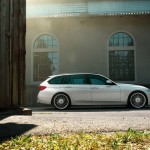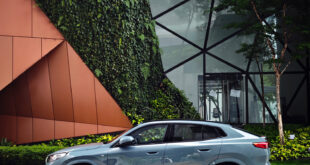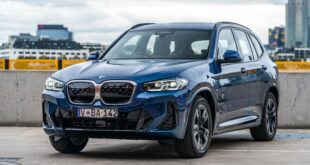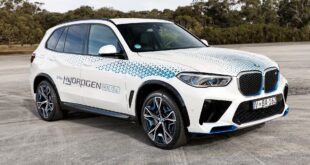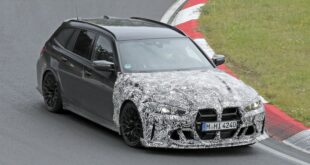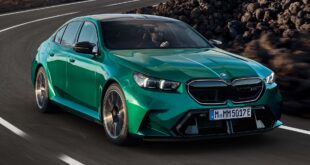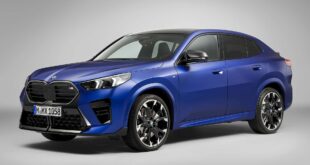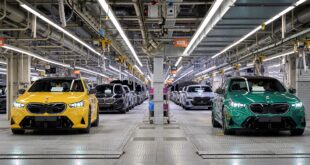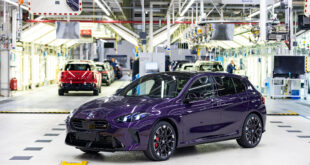THE NEW BMW ALPINA D3 BITURBO
The new BMW ALPINA D3 Bi-Turbo sets entirely new standards of performance and efficiency in its segment – all in the familiar, harmonious ALPINA style.

The numbers 2, 3, 4, 5, 6 and 7 summarise the key data of the new D3 Bi-Turbo like pearls on a chain: Vmax 278 km/h, 350 bhp, 4.6 s from 0-100 km/h, 5.3 l/100 km (139 g/km CO2), EU6, 700 Nm.
The first D3 to come out of Buchloe appeared in 2005 as a turbocharged, 2-litre in-line four cylinder model, and delivered a number of surprises – it was not the first diesel to wear the ALPINA badge, but it was unusual for ALPINA not to lead the performance table and instead go with an engine that albeit extremely economical had a small displacement. This D3 later advanced to become the Bi-Turbo, acquiring significantly more driving culture and performance in the process. Together with an extensive range of body styles and the typical harmonious interaction of performance, poise and handling, this model became the highest selling BMW ALPINA to date, with a total of over 2000 vehicles delivered.
The new D3 Bi-Turbo presented at the 2013 Frankfurt Motor Show is a logical and consistent step: the extremely successful and proven straight-six 3-litre diesel with Bi-Turbo charging, known from the D5 Bi-Turbo and most recently also the XD3, now finds its way into the new and multi-award winning BMW 3 Series.
With the new BMW ALPINA D3 Bi-Turbo, ALPINA is once again setting the benchmark, combining extraordinary performance and excellent efficiency with familiar ALPINA virtues appreciated by our customers worldwide.
DRIVE
The Bi-Turbo drive draws on the excellent characteristics of the underlying BMW fully aluminium, straight-six 3-litre capacity engine, the latest generation of common rail direct injection and a two-stage turbocharger with variable turbine geometry.
With the freedom that a small series provides, our engineers have further exploited the potential of this drive unit and in particular reduced pressure losses by optimising the intake paths and achieved effective dethrottling of the intake paths from the air intake to the air filter body, which results in more power and a more responsive engine. By also exploiting the achievable charge air and injection pressure, this gives a maximum power output of 350 bhp (257 kW) at 4,000 rpm and an impressive 700 Nm of torque between 1,500 and 3,000 rpm.
The output of the entire cooling management system has a decisive influence on the stability and performance of charged engines – so cooling is also of central importance in the D3 Bi-Turbo. A large-volume intercooler with optimised inlets and outlets supplies the engine with fresh air. Two radiators positioned in front of the wheel arches for ideal airflow ensure optimal operating temperatures for all coolants (incl. oil/water heat exchanger) – even under peak thermodynamic loads.
On the exhaust side, an exhaust manifold made from the super-strong material D5S allows the maximum exhaust temperature associated with the high power output to be increased by 50 ÌŠC.
The after-treatment of exhaust gases with a maintenance-free diesel particulate filter and an NSC catalytic converter (NOx storage catalytic converter) facilitates compliance with the EU6 emission standards.
With its sensitive sound application and reduced silencer volume, the exhaust system provides a surprisingly throaty soundtrack for a diesel, especially at higher engine speeds. Beyond the centre silencer, it has a special pipe layout in stainless steel, which ends in two elliptical twin tailpipes bearing the ALPINA and Akrapovič logos.
It is a real delight to extract the revving characteristics of the engine in a way that is somewhat untypical for a diesel and to enjoy the performance and torque in the compact 3 series bodywork.
In addition to the considerable specific output of 117 bhp per litre of capacity, the excellent combined fuel consumption based on the ECE standard also impresses at just 5.3 l/100 km and 139 g/km of CO2.
TRANSMISSION
The hardware of the 8-speed sports automatic transmission with ALPINA SWITCH-TRONIC, further developed in collaboration with ZF, is explicitly aimed at satisfying the requirements of the high torque generated by the D3 Bi-Turbo. The adapted mechatronics and a special torque converter ensure that power is transmitted with maximum efficiency and comfort to the drive wheels on the rear axle.
With regard to the software, the ALPINA engineers have given the transmission extraordinarily pronounced comfort and sports characteristics. High torque at low engine speeds combined with 8 speeds offers very fast gear changes in Automatic Mode with no loss of traction – effortless, relaxed and low-consumption cruising in high gears becomes a pleasure.
In addition to Automatic mode, the transmission has two further transmission modes tuned by APLINA. Sport Mode is lively, more dynamic – the gears are held for longer and the shift times are shorter. In Manual Shift Mode, the driver takes over full control of each gear change and uses the SWITCH-TRONIC buttons on the back of the steering wheel to personally select the gear, depending on the traffic and road conditions. Despite the constantly high torque curve, the system can also perform multiple downshifts in fractions of a second as required and when commanded to do so by the driver. If the driver further influences the ‘sharpness’ of the drive characteristics and power produced by the engine using the Drive Performance Control (see SUSPENSION/CHASSIS), the D3 Bi-Turbo accelerates from 0 to 100 km/h in just 4.6 seconds and reaches a top speed of 278 km/h.
In conjunction with the Manual Shift Mode of the ZF 8-speed sports automatic, the driver has a completely new feature available to him or her by selecting the Drive Performance Control setting Sport+ or DSC Off: no mandatory upshift. This lets particularly skilled drivers select the gear appropriate to the road conditions (e.g. tight corners) during concentrated driving, which prevents them from being domineered by the transmission changing up through the gears.
The ECO PRO mode including coasting is also used in adapted form in the D3 Bi-Turbo. The mode activates much more defensive transmission and accelerator pedal characteristics, which in total and in conjunction with other BMW Efficient Dynamics measures, such as the automatic start-stop function, make a considerable contribution to reducing fuel consumption, depending on personal driving behaviour.
SUSPENSION/CHASSIS
Like every automobile made by ALPINA, the new D3 Bi-Turbo also places special demands on its chassis. The intelligent chassis layout permits a high level of comfort over long distances and in urban traffic, as well as marked driving dynamics and sportiness. The adaptive ALPINA sports chassis solves this conflict of interests by means of electronically adjustable dampers in collaboration with tuned springs, additional springs and anti-roll bars. It allows the driver to use the Drive Performance Control to select the chassis setting and driving dynamic properties (Eco Pro, Comfort, Sport, Sport+). Subtle measures taken on the elastokinematics as well as on the camber and toe- in values adapted to the wheel/tyre combination achieve the neutral handling that is typical of ALPINA. The 19†ALPINA CLASSIC wheels with MICHELIN Pilot Sport tyres, in conjunction with a stiffening of the body at the front of the car, contribute to the high level of accuracy, precise steering behaviour and light handling. Overall, the chassis offers a high degree of comfort and sportiness, achieves neutral handling across a wide range of driving situations and ensures stability – and therefore a good sense of safety even at high speeds.
The Drive Performance Control also controls further parameters that influence the driving dynamics, such as the power steering and the driving stability control system.
The latter is subject to an ALPINA-specific sporty coding designed for the chassis of the D3 Bi-Turbo. The variable sports steering from BMW, which is installed as standard, has a progressive characteristic that significantly reduces the steering movements required when parking, for example.
Optimal braking values are provided by an 18“ high-performance brake system, with 370 mm brake discs at the front and 345 mm brake discs at the rear. Aluminium callipers (4-piston on front axle, 2-piston on rear axle) painted in blue and bearing the ALPINA logo, in conjunction with highly temperature-resistant pads, ensure fading stability and excellent pedal feedback.
In order to ensure brisk and dynamic driving also in the winter months, an ALPINA CLASSIC 19†winter wheel set is available with MICHELIN Pilot Alpin PA3 M+S tyres all round (8 x 19†at front, 9 x 19†at rear) with 245/35 R19 93W (245/35 R19 93W C /E / 73 dB).
ALL-WHEEL-DRIVE
The optional all-wheel drive available in the D3 Bi-Turbo Touring uses the technical possibilities of the BMW xDrive System, whose intelligent and dynamic control distributes the drive forces smoothly and fully variably between the front and rear axles in milliseconds, thereby ensuring even more traction and superior performance in all driving situations.
The torque distribution control unit connected to the ALPINA engine management and chassis control systems significantly increases driving dynamics and agility, particularly during high lateral acceleration, and produces unexpectedly sporty and neutral handling.
The new BMW ALPINA D3 Bi-Turbo Touring All-Wheel-Drive is in fact the fastest accelerating diesel car ever to come out of Buchloe, capable of sprinting from 0 to 100 km/h in just 4.5 seconds. Besides ensuring optimal traction during acceleration, the system also permanently monitors the driving conditions and actively distributes the drive torque to ensure a high degree of propulsion and safety at all times, for example on snow or road surfaces with abrupt changes in the friction coefficients.
DESIGN & EQUIPMENT
The D3 Bi-Turbo with 19†ALPINA CLASSIC wheels comes across as visually present and powerful, while the ALPINA aerodynamic components fit nicely into the modern design.
The functional design of the front spoiler ensures the effective flow of air to various cooler modules and the brake air guides. In combination with the rear spoiler (Saloon), this achieves excellent downforce/lift coefficients, which contribute significantly to driving stability, in particular at high speeds. Slight downforce is created on the front axle, and only marginal lift on the rear axle.
The new D3 Bi-Turbo has an sensible range of standard equipment, including sports seats, climate control and Xenon headlights. The interior is dominated by refined materials and a wonderful ambience. The door sills, floor mats, emblems in the seatbacks, the blue instrument cluster and a hand-stitched sports steering wheel in the finest LAVALINA leather make discreet references to the car’s exclusive origins.
Virtually no limits are placed on the individual design of a BMW ALPINA. From the paintwork to the interior trims to the colour of the upholstery – everything offered by the extensive BMW and ALPINA equipment range is available. Seldom does a BMW ALPINA leave the plant in Buchloe without making use of the virtually limitless personalisation options offered by the ALPINA factory. Our philosophy dictates that the customer can design his or her interior individually – assembled by skilled craftsmen in our leather workshop.
 BMW.SG | BMW Singapore Owners Community The Ultimate BMW Community – Established Since 2001
BMW.SG | BMW Singapore Owners Community The Ultimate BMW Community – Established Since 2001










